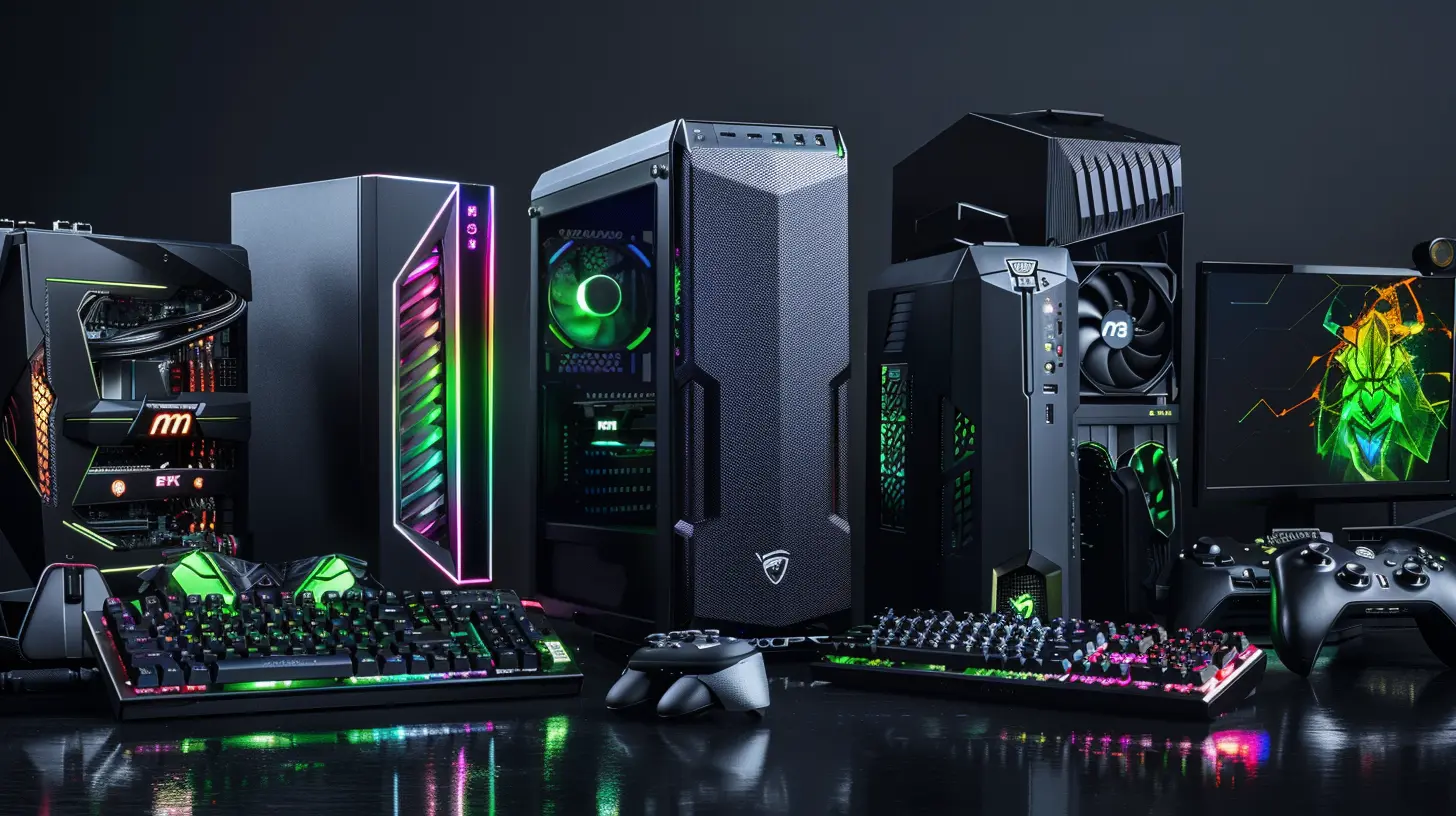Does RGB Really Boost Your Gaming Setup? A Deep Dive into Aesthetics and Performance
21 November 2025
Let’s be honest — when you walk into a room and see a gaming setup glowing like a neon-lit spaceship ready for launch, it turns heads. RGB (Red, Green, Blue) lighting has become the poster child of modern gaming culture. From keyboards and mice to RAM sticks and even monitor backlights, RGB is everywhere. But have you ever stopped to wonder, does RGB really do anything for your gaming performance, or is it just eye candy?
In this article, we’re going to peel back the layers of this colorful phenomenon and find out whether RGB is just a flashy gimmick or if it actually amps up your gaming rig in meaningful ways. So sit back, grab your favorite snack, and let’s dive deep into the vibrant world of RGB.
What Is RGB, Really?
Alright, before we get too far ahead of ourselves — what exactly is RGB in the gaming context?RGB stands for Red, Green, Blue, and it's the basis for pretty much every color you see on a screen. By combining these three colors in different intensities, you can create millions of different hues. In gaming setups, RGB lighting involves LED lights that cycle through colors, are customizable, and can even sync up with music, in-game actions, or other RGB components.
So why is it such a big deal in gaming?
Simple answer: It looks freaking cool.
But let’s dig deeper.
The Allure of RGB — Aesthetics Matter
Let’s not kid ourselves — aesthetics do play a vital role in how we perceive quality and performance. Just like wearing a new outfit can make you feel more confident, a slick, RGB-lit setup can spark that sense of excitement every time you sit down to game.Why Gamers Love the Glow
- Customization: RGB allows for endless personalization. You can match your lighting with your room, your mood, or even your game.- Immersion: Some RGB setups sync with gameplay. Imagine your room glowing red during an intense battle or blue while sneaking through a stealth mission.
- Community: RGB setups are showpieces. Posting your setup on forums or social media? That lighting better be on point.
Let’s face it, part of the fun of gaming is making your space truly yours. RGB helps you do just that.
But Does It Improve Performance?
Okay, here’s the million-dollar question: can RGB actually help you play better?The truth? Not directly. RGB lighting won’t increase your frame rate or lower your ping. It’s not going to boost your GPU clock speed or make your mouse more accurate. But — and this is a big BUT — it can have an indirect effect on how you perform. Let me explain.
The Psychology Behind the Lights
Ever heard of “mood lighting”? It’s not just a buzzword. The ambiance of your gaming environment impacts your mental state. And when you’re comfortable and feeling good, chances are, you’ll play better.Here’s how RGB might give you that edge:
- Focus: Subtle lighting can reduce screen glare and eye strain during long sessions.
- Energy: Bright, dynamic colors can energize you — especially during late-night gaming marathons.
- Relaxation: Soothing color schemes can help you stay calm under pressure, which is crucial in competitive games.
So is RGB a performance booster? Not in the traditional sense. But in the right context, it supports your mental game.
RGB and Productivity — More Than Just Gaming
Here’s a fun twist: RGB doesn’t just look cool and help with gaming. It can actually boost your workflow if you're also using your setup for content creation, school, or work.Setting the Mood for Work and Play
With software like Razer Synapse or Corsair iCUE, you can create profiles for different activities. Want that electric blue glow during a late-night gaming sesh? Done. Need warm amber lighting for writing a paper or editing video? Easy.Switching between custom lighting modes can literally flip the switch in your brain between play and focus.
Synchronization and Smart Integration
Another thing that makes RGB kind of awesome? Everything talks to each other now.Modern RGB setups allow full synchronization between different components:
- Motherboard
- RAM
- GPU
- Cooling fans
- LED strips
- Peripherals (keyboard, mouse, headset)
With programs like MSI Mystic Light, ASUS Aura Sync, and Logitech G Hub, you can control your entire setup from one place.
This ecosystem gives off major “sci-fi command center” vibes, and if that doesn’t motivate you to sit down and play (or work), what will?
Do Pros Use RGB?
You might be thinking, “Alright, if RGB is that cool, why don’t all the esports pros and streamers rely on it?”Truth is — many of them do, but not always while competing. At tournaments, setups are minimized for performance efficiency, and RGB isn’t a priority.
However, check out their home setups. You’ll see RGB everywhere — on walls, desks, chairs, you name it. Streamers especially love RGB because it brings personality and flavor to Twitch and YouTube streams. It’s not just about playing well; it’s about creating an experience.
Downsides of RGB — Let’s Keep It Real
Okay, we’ve hyped up RGB plenty. But let’s address the downsides, because yeah, there are a few.1. Price Tag
RGB components usually come with a bump in cost. A fan without RGB might cost $10, while an RGB version could be $20 or more.2. Power Consumption
While LEDs are relatively efficient, anything extra plugged in adds to your overall power usage. It’s not a huge deal, but it's something to note.3. Can Be Distracting
If not configured properly, RGB lights can be more annoying than helpful. Flashing rainbow effects mid-game? No thanks.4. Software Clutter
Managing RGB across multiple brands? Good luck. You might end up with three or four different programs running just to sync everything — and that can slow your PC or lead to conflicts.RGB Done Right — Tips for Your Setup
Want to make RGB really work for you? Here’s how you do it without going overboard:1. Choose a Theme
Pick a color scheme that matches your vibe — like ice blue and white for a clean look, or red and black for an aggressive style.2. Sync It Up
Use compatible components so you can control everything from one software. Consistency is key.3. Less Can Be More
You don’t need every piece to pulse like a disco. Use ambient lighting or accents for a more refined touch.4. Functional RGB
Go for RGB where it serves a dual-purpose. For example:- Keyboards with backlit keys for dark rooms.
- Mice with DPI indicators.
- Headsets with visual mic mute cues.
Final Thoughts: Is It Worth It?
So, does RGB really boost your gaming setup?Here’s the honest answer: If you’re only looking at raw performance — like higher FPS or lower latency — RGB won’t do much. But in terms of experience, atmosphere, and aesthetic appeal, RGB can transform your setup from “meh” to “marvelous.”
It won’t make you a better gamer overnight, but if it puts you in a better mental space, motivates you to spend more time at your PC, or simply makes you smile when the lights catch your eye — then yeah, it’s absolutely worth it.
After all, gaming is about enjoyment, immersion, and expression. RGB is just one of the many tools we can use to amplify that.
So go ahead… Light it up.
FAQs About RGB in Gaming
Q: Does RGB slow down my computer?A: Not really. RGB software uses minimal resources. Just avoid running multiple programs for different components if you can.
Q: Can RGB lighting be turned off?
A: Yep. Most RGB components let you disable or change lighting via software or onboard buttons.
Q: Is white lighting better for my eyes?
A: Warm white lighting can reduce strain in dark rooms. Cool colors like blue or purple are more energizing but can be tiring long-term.
Q: Are RGB components always more expensive?
A: Usually, yes. The extra LEDs and circuitry add to the cost — but some budget RGB options offer great bang for your buck.
all images in this post were generated using AI tools
Category:
Hardware ReviewsAuthor:

Pascal Jennings

